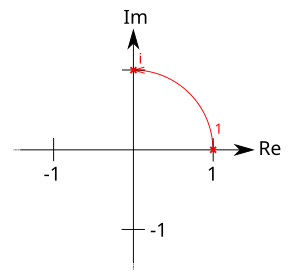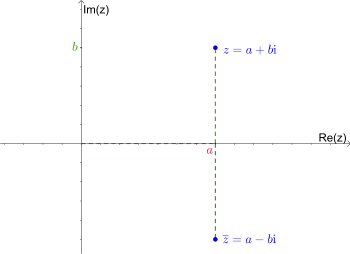Absolute value and conjugation – Serlo
Absolute value of a complex number
[Bearbeiten]Motivation of the absolute value
[Bearbeiten]When dealing with real numbers, we introduced the absolute value function , with which we could specify the distance of a certain number to zero. Visualised on the real number line this looks as follows:

Also in the complex plane we can determine the distance of a complex number from the zero point. For this we use the theorem of Pythagoras. Let be a complex number:

With the Pythagorean theorem, for the distance from zero, we have . By taking roots on both sides, can be determined. There is:
The absolute value transfers some concepts of real numbers to the complex numbers. As in the real numbers is the distance between and , so is in the complex numbers the distance between and . The distance in turn can be used to define terms such as a limit: A complex number is the limit value of a sequence of complex numbers, if the distance between the limit value and the sequence elements becomes arbitrarily small (below any ).
Definition of the complex absolute value
[Bearbeiten]Definition (absolute value of a complex number)
Let . Then, we define and call the number the absolute value of .
Hint
The absolute value defined above on the complex numbers coincides to the usual absolute value for real numbers. Consider . Then, there is:
Complex conjugation
[Bearbeiten]Motivation of the conjugation
[Bearbeiten]The imaginary unit as a root of fulfils the equation . We can imagine the multiplication as a rotation around the zero point. Now because of the equation , the multiplication is the same as . Thus, is an operation that corresponds to a rotation when used twice.
If a double multiplication with corresponds to a rotation, then a single multiplication must correspond to a rotation. In particular, the imaginary unit is equal to the number which results from a rotation of the number by :

It is common in Mathematics to turn counter-clockwise. Thus, is located where in the lies on the axis. However, one could just as well have turned clockwise. Then the would lie at the position of the on the axis:

We could also have derived the complex numbers from this alternative rotation. In that case we would have obtained a different set of complex numbers where the imaginary unit is below the axis. In this alternative set of complex numbers the roles of and are reversed. So if we swap everywhere, essential properties and structures obtained by number range expansion should be preserved. Such an interchange is shown in the figure:
In this figure, the imaginary part is multiplied by . This corresponds to a reflection of the complex number on the real () axis:

An example where this reflection is useful are the zeros of the function . There is . Therefore is a zero of . On the other hand there is also and therefore is another zero. Let us consider with the zero . One might think that the negative of the number, , is another zero. Unfortunately this is not the case. But if we exchange with , i.e. if we look at the complex number , we get another zero:
For die Nullstelle eines Polynoms scheint das an der reellen Achse gespiegelte eine weitere Nullstelle zu sein. Dies ist im Übrigen for all Polynome with rein reellen Koeffizienten der Fall. Dies weist darauf hin, dass die Abbildung eine Besondere ist. Diese Abbildung wird complex Konjugation genannt.
For the zero point of a polynomial, the mirrored on the real axis seems to be another zero point. This is the case for all polynomials with purely real coefficients. This indicates that the mapping might be particularly useful. As you progress with your math studies, you will see that it is useful in many more situations. So we better give it a name. Let's call it complex conjugation (since it connects/ conjugates and ).
Definition of the complex conjugation
[Bearbeiten]Definition (complex conjugation for a complex number)
Let . Then, the mapping is called complex conjugation and the number is the complex conjugate of .
Overview: Properties of the absolute value and the complex conjugation
[Bearbeiten]Properties of the complex conjugation
[Bearbeiten]For all and there is:
Properties of the absolute value of a complex number
[Bearbeiten]For all and there is:
- and (positive definiteness)
- (multiplicativity)
- and
- (triangle inequality)
Computation rules for complex conjugation
[Bearbeiten]Conjugation does not change real numbers
[Bearbeiten]Theorem (Conjugation does not change real numbers)
For a number there is if and only if is purely real, i.e. .
Proof (Conjugation does not change real numbers)
Proof step:
Let with and . There is then
Hence so is a real number.
Proof step:
Let be a real number. That means, . We have:
Involution
[Bearbeiten]Theorem (Involution)
For a complex number there is:
Proof (Involution)
Let with . Then, there is:
This can also be explained as follows: is the reflection of on the real axis. So is the reflection of the reflection, which is just the original complex number.
Compatibility with addition
[Bearbeiten]Theorem (Compatibility with addition)
For complex numbers there is:
Proof (Compatibility with addition)
Let be of the form , where and of the form , where . Then, there is:
Compatibility with multiplication
[Bearbeiten]Theorem (Compatibility with multiplication)
For complex numbers there is:
Proof (Compatibility with multiplication)
Let be of the form , where and of the form , where . Then, there is:
Compatibility of conjugation with finite sums and products
[Bearbeiten]We know how the conjugation behaves with the sum and product of two numbers. What happens with sums and products with three or more numbers like ? We use a trick: First, we consider as a single complex number. Then,we twice use the theorem of conjugation and sum:
There is also no difference for three summands if we first sum everything and then apply conjugation to the resulting number, or if we first conjugate every number and then sum everything. This is generally true for arbitrary sums and products of complex numbers, as we will prove below via induction.
Theorem (Compatibility for arbitrarily many complex numbers)
For every and all complex numbers there is:
Proof (Compatibility for arbitrarily many complex numbers)
We prove this theorem for the sum via full induction. The proof for the finite product can be done analogously.
Theorem whose validity shall be proven for the :
1. Base case:
1. inductive step:
2a. inductive hypothesis:
2b. induction theorem:
2b. proof of induction step:
Computation of the real and imaginary part
[Bearbeiten]Theorem (Computation of the real and imaginary part)
For a complex number there is:
Proof (Computation of the real and imaginary part)
Let with . We verify this equation by direct computation, starting from the right:
Computation of the absolute value via conjugation
[Bearbeiten]Theorem (Computation of the absolute value via conjugation)
For all complex numbers there is . So .
Proof (Computation of the absolute value via conjugation)
Let be an arbitrary complex number with . We compute . There is and . So there is
Since is real and the basis is non-negative,m we can take the root and obtain the real number .
Compoutation of the inverse via conjugation
[Bearbeiten]Theorem (Compoutation of the inverse via conjugation)
For all complex numbers there is .
Proof (Compoutation of the inverse via conjugation)
Let be an arbitrary complex number. We want to show . This is done by proving . With we get
Because the inverse is unique in a field, follows. This proves that is equal to the inverse of .
Hint
When proving that the complex numbers form a field, we have also derived a multiplicative inverse of . There we have seen . This is consistent with the new representation by complex conjugation:
Conjugation of fractions
[Bearbeiten]Theorem (Conjugation of fractions)
For all complex numbers with there is:
Proof (Conjugation of fractions)
We already know that for the inverse of a complex number there is: . We have also seen that real numbers are not changed by the conjugation and that the conjugation is compatible with the multiplication. We first show: . For this we use that is real and that holds.
This gives us for the conjugation of fractions of complex numbers with :
Properties of the complex absolute funciton
[Bearbeiten]Positive definiteness
[Bearbeiten]Theorem (Positive definiteness)
Let be a complex number. Then, there is:
Proof (Positive definiteness)
Let be given in Cartesian form. Then, there is . Now we still have to prove the equivalence. For this we show two implications:
Proof step:
Let . Then, there is . So we have .
Proof step:
This direction is shown by contradiction. Let . This implies or . If then, there is . For there is . In every case we have and hence .
Multiplicativity
[Bearbeiten]Theorem (Multiplicativity)
For there is .
Proof (Multiplicativity)
Let and . Then, there is
Since the bases and of the both squares are non-negative, we are allowed to take the root on both sides. Thus, we get .
Estimating real and imaginary part
[Bearbeiten]Theorem
For all there is and .
Proof
Let with . Then with , we have:
Analogously from , we get:
Triangle inequality
[Bearbeiten]Theorem (Triangle inequality)
For all there is .
Proof (Triangle inequality)
Let and . In order to estimate the absolute value, we use the relation :
Estimating the absolute value
[Bearbeiten]Theorem
For all there is .
Proof
First, we show that the square of the inequality holds.
The two bases and are non-negative numbers, so we can take the root on both sides of the inequality. This root preserves inequalities and thus .
Inverse triangle inequality
[Bearbeiten]Theorem (Inverse triangle inequality)
For complex numbers there is .
Proof (Inverse triangle inequality)
In order to prove an inequality , we can also just prove the two inequalities and . We will apply exactly this technique: in the following, we establish the two inequalities and .
Let's start with the first inequality. We use the triangle inequality of the complex amount and the trick of "inserting a fruitful " (which often appears together with triangle inequalities):
By transformation we obtain . We show the second inequality analogously, where the roles of and are reversed. In addition, we gradually transform into :
This implies . So in all, we have proven the two inequalities and . This establishes .




















![{\displaystyle {\begin{aligned}|z|&={\sqrt {{\text{Re}}(z)^{2}+{\text{Im}}(z)^{2}}}={\sqrt {a^{2}+0^{2}}}={\sqrt {a^{2}}}\\[0.3em]&={\begin{cases}a,&{\text{if }}a\geq 0,\\-a,&{\text{if }}a<0.\end{cases}}\end{aligned}}}](https://wikimedia.org/api/rest_v1/media/math/render/svg/d06610eae4fcb65f312279c66fcd8401f3a74da9)











































































![{\displaystyle {\begin{aligned}{\overline {\sum _{k=1}^{n+1}z_{k}}}&={\overline {\sum _{k=1}^{n}z_{k}+z_{n+1}}}={\color {OliveGreen}{\overline {\sum _{k=1}^{n}z_{k}}}}+{\overline {z_{n+1}}}\\[0.5em]&{\color {OliveGreen}\left\downarrow \ {\text{induction assumption}}\right.}\\[0.5em]&={\color {OliveGreen}\sum _{k=1}^{n}{\overline {z_{k}}}}+{\overline {z_{n+1}}}=\sum _{k=1}^{n+1}{\overline {z_{k}}}\end{aligned}}}](https://wikimedia.org/api/rest_v1/media/math/render/svg/a928ae4c5cc63d0ce1daf741ecd18010624e62f9)
![{\displaystyle {\begin{aligned}{\frac {1}{2}}\cdot \left(w+{\overline {w}}\right)&={\frac {1}{2}}\cdot (a+b\,\mathrm {i} +(a-b\,\mathrm {i} ))\\[0.3em]&={\frac {1}{2}}\cdot (a+a+b\,\mathrm {i} -b\,\mathrm {i} )\\[0.3em]&={\frac {1}{2}}\cdot (2a)=a=\mathrm {Re} (w)\\[0.3em]{\frac {1}{2\mathrm {i} }}\cdot \left(w-{\overline {w}}\right)&={\frac {1}{2\mathrm {i} }}\cdot (a+b\,\mathrm {i} -(a-b\,\mathrm {i} ))\\[0.3em]&={\frac {1}{2\mathrm {i} }}\cdot (a-a+b\,\mathrm {i} +b\,\mathrm {i} )\\[0.3em]&={\frac {1}{2\mathrm {i} }}\cdot (2b\,\mathrm {i} )=b=\mathrm {Im} (w)\end{aligned}}}](https://wikimedia.org/api/rest_v1/media/math/render/svg/8b6dd35ba342d6e043ecae495bc28b4e3c14ccb5)


















![{\displaystyle {\begin{aligned}{\overline {\left({\frac {1}{w}}\right)}}&={\overline {\left({\frac {\overline {w}}{|w|^{2}}}\right)}}={\overline {\left({\overline {w}}\cdot {\frac {1}{|w|^{2}}}\right)}}={\overline {\left({\overline {w}}\right)}}\cdot {\overline {\left({\frac {1}{|w|^{2}}}\right)}}\\[0.5em]&={\overline {\left({\overline {w}}\right)}}\cdot {\frac {1}{|w|^{2}}}={\overline {\left({\overline {w}}\right)}}\cdot {\frac {1}{|{\overline {w}}|^{2}}}={\frac {\overline {\left({\overline {w}}\right)}}{|{\overline {w}}|^{2}}}={\frac {1}{\overline {w}}}\end{aligned}}}](https://wikimedia.org/api/rest_v1/media/math/render/svg/23a8884c0a9bb19894d4ed631ab071b120b97aa0)


























![{\displaystyle {\begin{aligned}|w+z|^{2}&=(w+z){\overline {(w+z)}}\\&=(w+z)({\overline {w}}+{\overline {z}})\\&=w{\overline {w}}+w{\overline {z}}+{\overline {w}}z+{\overline {z}}z\\&=|w|^{2}+(w{\overline {z}}+{\overline {w{\overline {z}}}})+|z|^{2}\\[0.3em]&{\color {OliveGreen}\left\downarrow \ {\text{For }}v\in \mathbb {C} {\text{ there is }}v+{\overline {v}}=2\mathrm {Re} (v)\right.}\\[0.3em]&=|w|^{2}+2\mathrm {Re} (w{\overline {z}})+|z|^{2}\\[0.3em]&{\color {OliveGreen}\left\downarrow \ \mathrm {Re} (w{\overline {z}})\leq |\mathrm {Re} (w{\overline {z}})|\leq |w{\overline {z}}|=|w||{\overline {z}}|=|w||z|\right.}\\[0.3em]&\leq |w|^{2}+2|w||z|+|z|^{2}\\&=(|w|+|z|)^{2}\end{aligned}}}](https://wikimedia.org/api/rest_v1/media/math/render/svg/d58e0db69cdc92e72619294987fdfd6aada44004)














